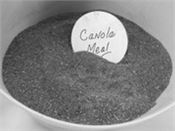|
Study Shows Response To Phytase Varies Among Canola Meal Varieties

URBANA, ILL.
Canola meal, which is included in diets fed to pigs as a protein source, is also relatively high in phosphorus. However, most of the phosphorus in canola meal is bound to phytic acid, and microbial phytase is often added to diets to help make more phosphorus available to pigs. New research from the University of Illinois shows that not all kinds of canola meal respond equally to the addition of phytase.
Hans H. Stein, professor in the Department of Animal Sciences and the Division of Nutritional Sciences at U of I, led a project to evaluate phosphorus digestibility in canola meal processed in different ways. Stein’s team fed growing barrows diets containing conventional canola meal (CM-CV), canola meal processed at a high temperature (CM-HT), canola meal processed at a low temperature (CM-LT), high-protein canola meal (CM-HP), or soybean meal as the sole source of amino acids and phosphorus. For each test ingredient, diets were formulated that contained either 0, 500, 1500, or 2500 phytase units (FTU) of microbial phytase, for a total of 20 diets.
Results indicated that if 0, 500, or 1500 FTU of phytase was added, there was no difference in phosphorus digestibility among the different canola meals. However, phosphorus digestibility was less in CM-LT than in the other canola meals when 2500 FTU of phytase was added.
Phosphorus digestibility was greater in soybean meal than in any of the canola meals when 0, 500, or 1500 FTU of phytase was added. Stein says that’s because a greater percentage of the phosphorus in canola meal is bound to phytic acid, and therefore unavailable to the pig.
“However, if more than 2000 FTU of phytase was added to the diets, the digestibility of phosphorus in all canola meal sources except CM-LT was equal to that in soybean meal,” Stein explains. “This indicates that with sufficient phytase in the diets, the phosphorus in canola meal can be made available to pigs.”
Stein’s team developed regression equations from the results of this experiment, which he says will make it possible to predict how much phosphorus will be released from canola meal or soybean meal for a given amount of phytase. ∆
|
|